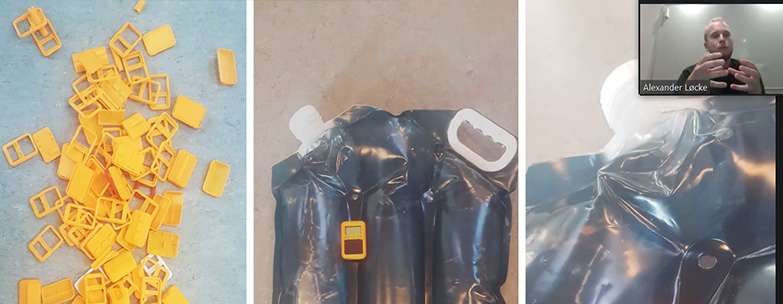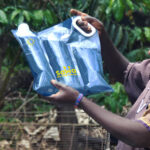Unique 3D print technologies presented at Brew Your Own event
A 3D-printer is basically a glue gun mounted at the end of a robot arm. Nonetheless, 3-D printing technologies are likely to change the game for almost all producers of physical products. If not in the actual production, then certainly in the prototype phase of the product cycle. That was the central take-home message from three start-ups and an institutional speaker at a Copenhagen Science City “Brew Your Own” event on 3D-printing for start-ups.
Bringing sustainability to aircraft and other manufacture
The European airplane manufacturer Airbus decided to 3D print a cockpit partition for a new airplane. Thanks to the design freedom allowed by 3D-printing, they were able to develop a partition so light, that it will save 465,000 tons of CO2 over its lifetime of flying. This was one of the examples given by Frank Rosengreen Lorenzen on how 3D-printing can be sustainable for the planet and for your business. Lorenzen is the CEO of Danish AM hub, which is an organisation promoting the development and use of 3D print and similar technologies to Danish industry.
Understanding the old to leverage the new
In his talk, Mr Lorenzen advised would-be entrepreneurs to understand the two traditional production methods to generate ideas for new businesses based on the novel additive technologies.
- Subtractive production processes such as milling, planing and drilling leaves waste behind. In contrast, 3D-print wastes almost no material, so waste streams are a good place to look for business ideas.
- Formative production such as injection moulding is expensive and time consuming to set up. 3D-print is cheap and fast, so customers who want individual, fast or low volume solutions are good to look for.
Scan the research to discover new possibilities
Finally, Mr. Lorenzen suggested looking to wasteful transport solutions to find needs where it makes sense to place production close to the consumer, and reminded the audience, that researchers are adding new printable materials on a daily basis.
An alternative to visible death
CTO Alexander Løcke represented the first start-up, Solarsack. Their product is a specially designed plastic container for sterilizing drinking water. Many poor people boil their water over wood fires to make it safe. In a Solarsack the water is purified by a combination of solar heat and UV-rays. Charcoal is ten times more expensive, but consumers “know death is happening” when they see fire and smoke.
Research and development at one fourth of normal cost
To satisfy users, Løcke had to come up with a “sterilization indicator” which measures solar input and displays a smiley face when the water is ready. This bit of electronics needed to be housed in a plastic casing. Printing it instead of moulding, allowed Løcke and his team to develop and produce 100 prototypes for just over 10,000 DKK. One quarter of the normal budget for such an R&D-job.
Shaving months and millions with new Danish technology
Prototyping is also an essential aspect of the next speaker’s business. Lasse Staal is the CEO & co-founder of the Danish company Addifab. They promise to shave months and millions out of your product development cycle with their novel technology “Free form injection moulding”.
Any material, any size, any shape
In conventional moulding the finished product must be designed for easy removal from the metal mould, the so-called “Tool Cavity”. Addifab 3D-prints individual moulds and wash the mould away from the finished part. This allows for almost complete freedom of design Mr. Staal explained, and elaborated.
We like to call our technology Production Grade Prototyping. Our technology allows finely detailed moulding in almost any material including glasses, ceramics and metals and in sizes down to about ten micrometres. This removes a number of traditional problems in moving from prototyping to production and also constitutes a recipe for the production of small runs such as spare parts”: Lasse Staal, CEO, Addifab
Not science fiction. Science fact
The final speaker, Maksym Plakhotnyuk, presented a technology, which he readily admits sounds like science fiction. He is the CEO and founder of ATLANT 3D Nanosystems, which is developing the world’s first atom layer 3D printer.
Using an atomic layer 3D-printer like our nanofabricator to build microchips and other micro and nano-scale devices may sound like science fiction, but we are doing it right now in our laboratory. We are confident that we can compete with traditional technologies such as thin film and photolithography because we estimate that we will provide design flexibility, rapid processing and even be 97 percent cheaper”: Maksym Plakhotnyuk, CEO, ATLANT 3D Nanosystems.
Expanding the realm of the possible… Daily
Macro scale 3D-printers squirt layer upon layer of a liquid to build the desired product. ATLANT 3D squeezes gasses through a micro nozzle that enables high precision chemical reactions to control extremely fine features. The technology has a potential to print more than 450 different materials, but Mr. Plakhotnyuk confided that they add new printable materials to their database every day.
What are Brew Your Own and who plans them?
This “Brew Your Own” event was planned and executed in collaboration with Danish AM-Hub and Biopeople, Denmarks Life Science Cluster which is a network organization bridging bioscience business and academic research. Brew Your Own events are aimed at entrepreneurs interested in co-creating with academics and at researchers and students interested in starting their own business or working for a start-up. The events provide inspiration, information and motivation.




